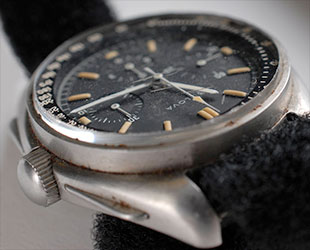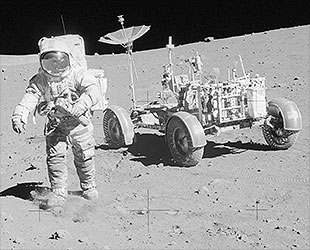September 30, 2015 – Forty-four years ago, David Scott's watch broke while he was out for a walk.
Somehow, the crystal that protected the wristwatch's face popped off. Scott did not notice it had broken until after he had come back inside. Fortunately for him, he had another watch to wear.
Of course, none of that would be noteworthy had Scott not been on the moon at the time.
The commander of NASA's Apollo 15 mission, Scott was the seventh person to walk on the moon and the first to drive a car there, the lunar rover, in July 1971.
He was also the first and only astronaut in history to wear a personal watch on the surface of the moon — a watch that is now heading to auction.
On Oct. 22, after a week of online bidding that will open at $50,000, Scott's personal Apollo 15-used chronograph will be sold by RR Auction of Boston. The sale is expected to draw watch and space collectors alike, as it the only time a watch worn on the moon has ever been offered.
Omega versus Bulova
When Scott launched from Earth, when he landed on the moon and when he and Apollo 15 astronaut Jim Irwin went outside for their first two moonwalks, Scott wore a NASA-issued Omega Speedmaster chronograph.
Selected by the space agency after a series of extensive tests, the Swiss-made watch was worn by all of the Apollo astronauts, from Neil Armstrong to the last man to walk on the moon, Gene Cernan. Omega inscribed the back of the Speedmasters it sold with the proud claim, "first and only watch worn on the moon."
Only the "only" wasn't precisely true.

David Scott's Bulova wristwatch worn on the moon. (RR Auction) |
Unbeknownst to most at NASA, let alone on Earth, at the time, Scott agreed to carry a Bulova-made wristwatch and stopwatch on board Apollo 15 after a bid by the New York-based watchmaker to demonstrate that an American-made piece could function as well, if not better, than the Swiss Speedmaster.
For Scott, it was all about ensuring that the mission was a success. For example, a situation could arise during their moonwalks that would require a precise knowledge of the oxygen and water remaining in the spacesuits' life support backpacks.
"Under certain anticipated operational conditions, the only method of monitoring these vital systems was with a wrist chronograph," Scott stated in an interview. "I only had the NASA-provided Omega Speedmaster, which was a single point failure under these conditions."
"As a matter of prudence, I then decided that I would also carry the Bulova as a backup," Scott recalled.
That decision ultimately paid off, as Scott discovered the crystal had gone missing from his Speedmaster following his second moonwalk. On Aug. 2, 1971, as he embarked on his third and final excursion out onto the lunar surface, Scott used the velcro watch strap he wore on his first two moonwalks to don his Bulova-made backup.
Unknown, unauthorized and misidentified
Though you would not know it unless you were looking for it, the Bulova chronograph can be seen in the footage and photos taken of Scott as he saluted the U.S. flag, worked near the lunar rover and famously proved for all those on Earth that Galileo was right — a feather and a hammer fall at the same rate in the absence of an atmosphere.

David Scott wore his Bulova watch on the surface of the moon for the length of his third moonwalk on Aug. 2, 1971. (NASA) |
He continued to wear the Bulova once he was back inside the lunar lander, all the way through to his splashdown on Earth with Irwin and Apollo 15 command module pilot Al Worden. A photo of the three astronauts floating in a life raft after the mission was completed provides perhaps the clearest view of the Bulova strapped to Scott's wrist.
Not that anyone noticed at the time.
"After the mission, only my supervisor and my crew knew that the Bulova [watches] had been carried," Scott stated. "Bulova was not informed."
And that may have been it had a question not arose about some souvenir envelopes ("covers") Scott had also flown for a German stamp dealer. An investigation, called for by Congress, revealed the "unauthorized timepieces."
"Thinking [the chronographs] might be useful, particularly for the possible emergency timing of a manually controlled propulsion maneuver, Scott carried them on the mission but without prior authorization," NASA officials reported in a 1972 press release.
The space agency withheld the name of the manufacturer to avoid commercialization.

Scott is auctioning his moon-worn Bulova chronograph together with the velcro strap he used on three moonwalks. (RR Auction) |
The secret out, the make of the watches would still remain unknown for 25 years, and even then, the wrong company was identified.
"In 1996, 25 years after the mission, I was queried about a backup watch. At that time, I slightly recalled that it was a Waltham. However, in 2014, after further researching the issue for an article on watches, I concluded that frankly, back in 1996, I just made a mistake – it was a Bulova, not a Waltham," Scott explained.
"Knowing what watch I wore was not a priority during [the] mission discussions, especially in light of the complexity of our flight to the moon. I hadn't fully researched many of the ancillary parts of the mission," he added. "More things [came] into focus in 2014 as more people were beginning to research Apollo in more depth."
Time to sell
In 2011, Scott sold his flown Bulova-made stopwatch to a private collector in Boston for an undisclosed amount. The wristwatch meanwhile, remained in a safety deposit box for another few years until Scott retrieved it in preparation for its upcoming auction.
The black dial Bulova, which resembles in some ways the design of the Omega Speedmaster with its three subdials, was never commercially offered by Bulova. The company did sell a model wristwatch called the Accutron Astronaut, but the name was inspired by its use by test pilots and the fact that Bulova watch movements were used in timers as part of the Apollo spacecraft and experiments.
Scott, through RR, is selling his moon-worn Bulova, along with the velcro watch strap he donned for all three outings.

Apollo 15 commander David Scott, left, can be seen wearing the Bulova wristwatch after his crew's splashdown on Earth. (NASA) |
After the Apollo program ended, NASA reaffirmed that the Omega Speedmasters worn to and on the moon remained federal property and donated them to the Smithsonian. As a result, Scott's Bulova is the only wristwatch worn on the moon that is in private hands and can ever be sold.
For his part, Scott hopes the auction results in the Bulova wristwatch taking its place in space history.
"Hopefully," he remarked, "the new owner will share it with as many interested parties as practical."
For more information or to bid, see RR Auction's website.
